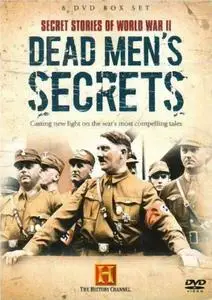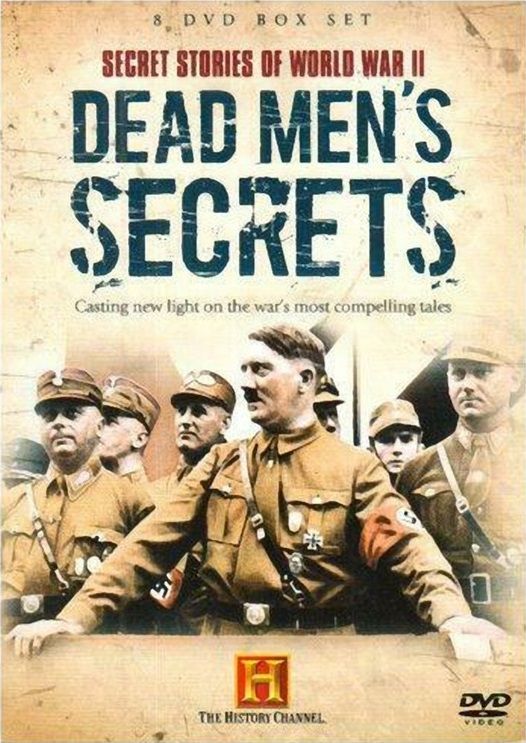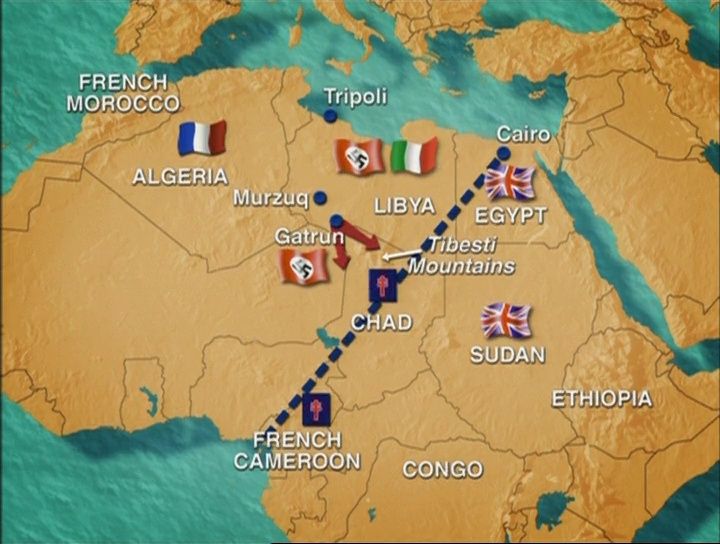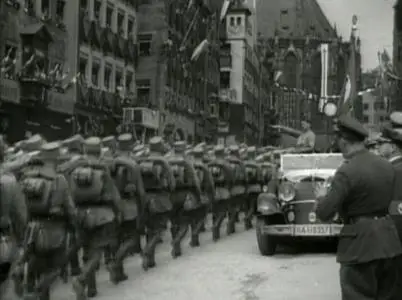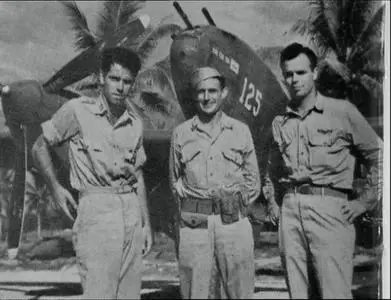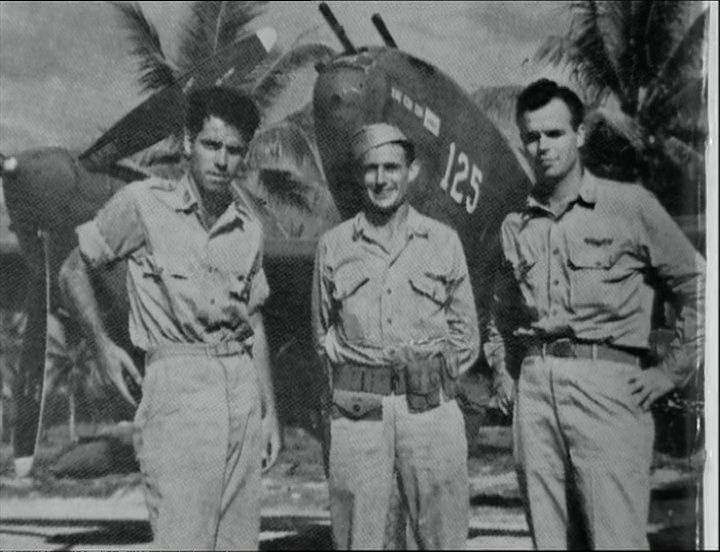History Channel - Dead Men's Secrets: Set 1 (2002)
DVDRip | 720 x 544 | .MKV/AVC @ 2118 Kbps | 14x~44mn | 10.1 GB
Audio: English AC-3 192 Kbps, 2 channels | Subs: None
Genre: Documentary
DVDRip | 720 x 544 | .MKV/AVC @ 2118 Kbps | 14x~44mn | 10.1 GB
Audio: English AC-3 192 Kbps, 2 channels | Subs: None
Genre: Documentary
Dead men don't tell tales - or do they? Are there forensic clues left in the sands of time? Are there traces of archive film which even today are waiting to unveil their grisly secret? Not all the captivating and fascinating stories of military escapades in the 20th Century have been fully examined and many fascinating insights are still to be revealed and told.
These have been known until now as DEADMEN'S SECRETS.
What was the true story behind the tragic death of John F Kennedy's older and better looking brother? Was this the man who Joe Kennedy Sr. was really grooming for President? Could his death have been avoided?
How was it possible for an American President to order the death in mid-air of the man who executed the raid on Pearl Harbor? Who tampered with the flying controls of General Sikorski's plane? And which secret frogman was first on the scene when the plane crashed into the sea? Why did Hitler murder his right-hand man and why did the bomb plot to kill Hitler fail?
How did the Allies execute a daring plot to kill Hitler's chosen successor and who set fire to the 'Normandie' before she could set sail from New York with 6,000 American troops on board?
Who really was 'The Man Who Never Was'? This and many other fascinating questions are answered in this new pivotal series entitled DEADMEN'S SECRETS.
With newly discovered archive film and new state of the art 3D computer graphics the series sets out to answer some of the most baffling questions and war mysteries of the 20th Century. What was the truth about Rudolf Hess and whatever happened to Raoul Wallenberg? What did the Oslo Report reveal and who wrote it? And how close was Hitler to developing the atomic bomb at the end of World War II? Some of the answers are both frightening and unexpected.
With the release of new Government information on both sides of the Atlantic it is now possible to painstakingly reconstruct some of the most famous mysteries of recent military history. DEADMEN'S SECRETS is the first serious attempt this Century to lay some of the last Century's most puzzling ghosts to rest.
Produced by Nugus/Martin Productions Ltd. for The History Channel
Part 1: The Mysterious Death of Joe Kennedy
He was a war hero with unlimited potential and his father's choice to become president. In August 1944 a heavily-laden US Navy Liberator took off from an English airfield, piloted by Joe Kennedy Junior. Many expected him to follow in the family tradition, and eventually make president of the USA, but that day he perished when his aircraft exploded before it even reached enemy airspace.
After two tours of duty in war-weary England, Joe Jr had flown enough combat missions to make him eligible to return home, his war over. Instead, Joe volunteered to stay in England, taking on even greater risks piloting dangerous missions to target Hitler's devastating V-bombing campaign. By August 1944, he stepped forward to co-pilot the launch of a top secret, perhaps near suicidal drone bombing mission. Departing from RAF Fersfield in Suffolk, the flight went badly wrong and the plane exploded shortly after take-off. The crew's bodies were never found. Eyewitnesses described two explosions and a huge ball of fire with debris scattered for at least a mile.
Kennedy was the daring test pilot in a highly secret and extremely dangerous operational trial involving a flying, remote-controlled bomb. What happened over British skies as he flew on a top-secret mission to take out a Nazi rocket base?
Part 2: The Mysterious Death of Yamamoto: Death by Presidential Decree
Japanese Admiral Isoroku Yamamoto was the mastermind behind the attack on Pearl Harbor. In the terrible times that followed a nation demanded revenge.
With astounding military precision, 16 Lockheed P-38 Lightning fighter planes flew 650 miles to intercept Yamamoto's aircraft as he made a routine flight to visit his forces. Their mission: hunt and destroy. The pilots had become assassins, and the death of Yamamoto was sanctioned by the President of the United States.
On April 18, 1943, the aircraft carrying Admiral Isoroku Yamamoto was shot down by U.S. fighters. Yamamoto–chief architect of the attack on Pearl Harbor–was visiting the forward Japanese bases at Bougainville, some 650 miles from the nearest U.S. base. His clash with U.S. fighters so far from their territory was more than simple bad luck–the pilots must have known where and when to find their target. We talk to the U.S. pilots and find out why the mission had to remain secret until war's end.
Part 3: The Mysterious Death of General Sikorski
Polish General Wladyslaw Sikorski was the Prime Minister of the Polish Government-in-exile during World War II, and commander of all Polish soldiers who had escaped the Nazis and returned to the fight. On July 4, 1943, the B-24 Liberator carrying him out of Gibraltar en route to London, failed to lift off after take-off, and crashed straight into the sea, killing Sikorski. The official line was that Sikorsky and his fellow passengers had died in an accident, but evidence of sabotage indicated otherwise. There was no official inquiry, and the real cause of Sikorski's death remains mystery.
DEAD MEN'S SECRETS analyses the accident and possible causes in detail. The pilot, who survived talks about the fatal flight, which is reconstructed using advanced computer graphics. Scholars explain how tensions with both Stalin and Churchill may have led these leaders to cause the crash. Who wanted Sikorsky dead? Could it be his Russian arch-enemy Stalin, or perhaps even Prime Minister Winston Churchill, who may have found him a troublesome ally? Finally, a third option points to the Polish military leadership. Could the Poles have plotted the death of their own leader, or was it simply an accident.
Part 4: Whatever Happened to Glenn Miller?
Big band leader Glenn Miller was the King of Swing until his Norseman light aircraft vanished over the English Channel in 1944. Was Miller in the wrong place at the wrong time when returning bombers offloaded their excess payload over the water, or was his death far more sinister? Why would the authorities cover up the musician's death? Could he have been a spy?
Bandleader Glenn Miller joined the flood of young Americans enlisting in the army in 1942 and was ordered to form a new 42-piece all-star band to entertain service personnel. With the liberation of Paris in 1944, a series of Miller concerts was planned. But when Captain Miller took off on a short hop across the English Channel to Paris on December 15, he was never seen again. No wreckage was found and no official explanation given. Did his aircraft simply fail, or was there a military coverup? This one-hour special attempts to get to the bottom of what happened on that fateful day.
Part 5: Why Did Hitler Murder Ernst Roehm?
It is hard to imagine the period of the NSDAP's rise to power in Germany without Sturmabteilung in their characteristic kepi caps and brown shirts. SA stormtroopers and their brutal commander, Ernst Roehm, not only gave Hitler invaluable services in his battles with political opponents, but also became an icon of the National Socialist movement of the early 1930s. When Adolf Hitler became chancellor of Germany, these ties began to weigh heavily on him. However, this did not determine the fate of Ernst Roehm, one of the oldest party comrades.
Even before World War II had started, Hitler had begun his killing career. In 1934, he had one of his best friends and loyal servants murdered. During the infamous 'Night of the Long Knives' SA leader Ernst Roehm's time was up. He had become too powerful, and his brown-shirted SA troops posed a threat to Hitler's personal bodyguard, the SS. Worse, he was a homosexual and to Hitler and his Nazis a pervert. When Hitler was forced to choose between loyalty and power, there would be no hesitation.
Part 6: Revenge! the Assassination of Reinhard Heydrich
Reinhard Heydrich was the perfect Nazi: tall, blond, athletic - and evil. Next to Hitler himself, Reinhard Heydrich was the most dangerous man in Nazi Germany. Hitler called him the "man with the iron heart". As head of the Security Police, even loyal Nazis feared him.
From his appointment as Reichsprotektor in Czechoslovakia and his determination to clear the country of Jews, he earned the nickname 'Hangman of Prague'. So the British government and the Czech leader in exile came up with a plan to assassinate him.
One morning in 1942, as Heydrich was driven through the streets of Prague, he was gunned down. The Czech people struck a blow for liberation, but in the reprisals that follow, many innocent people would pay with their lives.
Using archive footage and detailed maps, we reveal how the assassins trained and plotted to kill Gestapo chief. The plot to assassinate him was the only successful assassination of a leading Nazi during World War II, and the story behind it is retold here using a combination of dramatic reconstructions and historical footage.
Part 7: Secrets of Hitler's Special Forces
Here we are given a glimpse into the highly structured world of Hitler's Special Forces. These elite warriors could be called up from any military base because they were the best soldiers the Third Reich had to offer.
Hitler's Special Forces carried out some of the most daring raids of World War II: the first glider-borne assault on the Belgian fortress of Eben-Emael… a paratroop aerial assault on the island of Crete… and the audacious rescue of Italian dictator Benito Mussolini from his mountain-top prison high in the Gran Sasso range.
Led by the formidable Otto Skorzeny, Hitler's special forces were among the best in the world. For the first time, the hidden world of these elite forces is uncovered as we feature never-before-seen footage filmed by German cameramen.
Part 8: Plotting to Kill Hitler: Why Did the Plots to Kill Hitler Fail?
In 1939, with World War II barely underway, a bomb exploded in Munich's Burgerbrau Beer Hall minutes after Adolf Hitler and his top aides had left. It was just the first of many attempts made on the Nazi leader's life during the war.
The course of history could have been so different if the first plot to kill Adolf Hitler, in 1939, had been successful. But it seemed that Hitler was a hard man to kill. Over the course of the war several attempts were made on his life, but none were successful. This programme looks at the most famous attempts to bring WWII to a rapid end by assassinating the Fuhrer. Would be assassins include the Kreisau Circle, Colonel von Gersdorff, Operation Foxley, the Wolf's Lair Bomb and the Black Orchestra.
This programme analyses what went wrong. Eventually Hitler took his own life. Why had no-one else succeeded?
Part 9: Escape from Hitler's Bunker
In 1945 Soviet tanks roared through the flaming ruins of Berlin. In Hitler's bunker under the Reich Chancellery waited a group of the most hated men in history. The leader of Nazi Germany spent his final days cowering in his Berlin Bunker as his empire crumbled, before consuming cyanide and shooting himself with a pistol as the Red Army closed in. After storming central Berlin, the Soviets discovered Hitler's body, along with the lair 55 feet under the Reich Chancellery, which contained 18 small rooms and was fully self-sufficient, with its own water and electrical supply.
While Hitler and Goebbels killed themselves, others decided to make a break for it. Hermann Goering and Heinrich Himmler were caught soon after their flight from the bunker. But what happened to party secretary Martin Bormann and Gestapo chief Heinrich Muller?
With their city occupied and every Allied soldier on the lookout for high-ranking Nazi officials, how is it possible that these men escaped and where did they go?
Part 10: Hitler's Atomic Arsenal: How Close Was Hitler to Developing Atomic Weapons?
How close was the leader of the Third Reich to having a nuclear bomb to deploy against the Allies in World War II? After developing a V2 ballistic missile capable of reaching as far a New York, Hitler made nuclear development his highest priority. See how America's development of atomic warfare thwarted Hitler's aggressive plan to launch an atomic attack on San Francisco on August 17, 1945.
At the start of World War II, the race was already on between the Nazis and the Allies to be the first to create an atomic weapon.
By teaming up with the Japanese, Hitler planned to launch an atomic attack on San Francisco. The date was set for August 17th, 1945. But on August 6th an American Superfortress dropped an atomic bomb on Hiroshima, and the war was finished.
The race to nuclear war was won by the Allies - but only by a matter of days.
Part 11: The Strange Quest of Rudolph Hess
Adolf Hitler's deputy Rudolph Hess parachuted into a field in Scotland in 1941. He had come to contact members of the British Royal family on a secret peace mission that he hoped would end the war. He was captured by some locals and imprisoned, but rumours surfaced many years later questioning his identity - and the true extent of the Royal family's involvement.
On May 10th, 1941, a lone Messerschmitt Me-110 fighter-bomber flew over Scotland. The pilot parachuted out and was immediately imprisoned. His credentials said he was Captain Albert Horn, but he was immediately recognized as Rudolph Hess, the Deputy Fuhrer of the Third Reich. So what was he doing alone in enemy territory? Held in Berlin's Spandau prison until he committed suicide in 1987 at the age of 92, Hess always maintained that he was on a secret peace mission, hoping to meet with British officials and Royal Family members. His version of events has long been endorsed by British and German officials, but it has also been routinely challenged.
THE STRANGE QUEST OF RUDOLPH HESS examines the competing theories as to what he was doing in Scotland, looking at RAF reports, Nazi files and other sources for information. Among the most tantalizing threads uncovered are suggestions that the real Hess may not have survived the crash of his plane…
Part 12: America and the Mob: Wartime Friends - Who Set Fire to the Normandie?
1942. Fire blazed on the Normandie, a magnificent luxury ocean liner anchored in New York Harbour. She had just been renamed USS Lafayette and converted to a troop carrier, ready to take 10,000 American troops to Britain. Nazi sabotage was supected, but the official story was negligence. The government had to take steps to prevent such setbacks in the future. For decades rumours have persisted that one of the precautionary measures they took was to "hire" the Mafia to make sure no additional "accidents" happened. Of course, that looks suspiciously like a famously successful Mafia business model and there are some who believe that the Normandie fire was actually a shakedown. In fact, decades later Mafia chieftain Lucky Luciano claimed his organisation had burnt the Normandie, and in the aftermath had made a deal with the US government to protect the dock from further Nazi sabotage.
Could this really be true? Did the government enlist help from the least likely of sources - and under duress - from an underground enemy? With testimony from military scholars, Mafia experts and anonymous eyewitness to the Normandie fire, DEAD MEN'S SECRETS explores one of the most intriguing myths of America during WWII.
Part 13: Secrets of the "Y" Service
In World War II electronic warfare became crucial. The "Y" Service was a group of highly trained technicians who used technology to fight the war. Throughout the war, Allied code-breakers read the secret messages of the Germans. The men and women of the 'Y' (for Wireless') Service were sent out across the world to run listening stations from Gibraltar to Cairo, intercepting the German military's encrypted messages for decoding back at the now-famous Bletchley Park mansion.
Technicians listened in to enemy messages and pinpointed enemy radio, tracking the movements of ships, U-boats and aircraft around the globe. All this was coordinated by a group of highly-trained technicians working behind the frontline - the mysterious "Y" Service. We go inside this elusive global network as surviving operatives share their once secret stories and military historians examine the vital legacy of this shadowy corps.
Part 14: Operation Bodyguard: D-Day Deception
The Allies knew that to be successful on D-Day they must disguise where they would land; so they created an elaborate system of hoax and deception named Operation Bodyguard to fool the Germans who were waiting. There were fake armies, dummy landing craft and false intelligence, all designed to keep Hitler guessing about the true objective of the Allied landings.
It was an all-or-nothing proposition, one where turning back was impossible and failure unthinkable. But there was no guarantee of success and when the D-Day invasion was planned, the Allied commanders thought of every possible way to stack the odds in their favour. One of the most audacious of these plans involved the creation of a shadow force, one with virtually no troops or firepower whose success would not rely on the firing of a shot.
OPERATION BODYGUARD: D-DAY DECEPTION talks with military experts and historians to tell the complete tale of the phantom invasion of Pas de Calais, where Hitler came to believe that the Allied forces would land. See archival footage of the fake armies and dummy landing craft that supported this ruse and examine the carefully planted false intelligence that gave the story credence.
General
Unique ID : 255545865203446782491946961572392310703 (0xC04057E8CC4C8CB9A2E0618F39EF97AF)
Complete name : HC.Dead.Mens.Secrets.Set.1.01of14.The.Mysterious.Death.of.Joe.Kennedy.mkv
Format : Matroska
Format version : Version 4
File size : 741 MiB
Duration : 44 min 48 s
Overall bit rate : 2 312 kb/s
Encoded date : UTC 2020-03-23 10:29:04
Writing application : mkvmerge v44.0.0 ('Domino') 64-bit
Writing library : libebml v1.3.10 + libmatroska v1.5.2
Video
ID : 1
Format : AVC
Format/Info : Advanced Video Codec
Format profile : High@L4
Format settings : CABAC / 12 Ref Frames
Format settings, CABAC : Yes
Format settings, Reference frames : 12 frames
Codec ID : V_MPEG4/ISO/AVC
Duration : 44 min 48 s
Bit rate : 2 118 kb/s
Width : 720 pixels
Height : 544 pixels
Display aspect ratio : 4:3
Frame rate mode : Constant
Frame rate : 29.970 (30000/1001) FPS
Color space : YUV
Chroma subsampling : 4:2:0
Bit depth : 8 bits
Scan type : Progressive
Bits/(Pixel*Frame) : 0.180
Stream size : 679 MiB (92%)
Writing library : x264 core 66 r1092 60f4cd8
Encoding settings : cabac=1 / ref=12 / deblock=1:-2:-1 / analyse=0x3:0x133 / me=tesa / subme=8 / psy_rd=1.0:1.0 / mixed_ref=1 / me_range=32 / chroma_me=1 / trellis=2 / 8x8dct=1 / cqm=0 / deadzone=21,11 / chroma_qp_offset=-4 / threads=12 / nr=0 / decimate=1 / mbaff=0 / bframes=8 / b_pyramid=1 / b_adapt=2 / b_bias=0 / direct=3 / wpredb=1 / keyint=250 / keyint_min=25 / scenecut=40(pre) / rc=2pass / bitrate=2118 / ratetol=1.0 / qcomp=0.60 / qpmin=10 / qpmax=51 / qpstep=4 / cplxblur=20.0 / qblur=0.5 / vbv_maxrate=25000 / vbv_bufsize=14000 / ip_ratio=1.40 / pb_ratio=1.30 / aq=1:1.00
Default : Yes
Forced : No
Audio
ID : 2
Format : AC-3
Format/Info : Audio Coding 3
Commercial name : Dolby Digital
Codec ID : A_AC3
Duration : 44 min 48 s
Bit rate mode : Constant
Bit rate : 192 kb/s
Channel(s) : 2 channels
Channel layout : L R
Sampling rate : 48.0 kHz
Frame rate : 31.250 FPS (1536 SPF)
Compression mode : Lossy
Stream size : 61.5 MiB (8%)
Language : English
Service kind : Complete Main
Default : Yes
Forced : No
Menu
00:00:00.000 : en:Chapter 1
00:02:02.633 : en:Chapter 2
00:11:20.333 : en:Chapter 3
00:18:31.067 : en:Chapter 4
00:25:39.200 : en:Chapter 5
00:38:47.867 : en:Chapter 6
00:45:50.000 : en:Chapter 7
Unique ID : 255545865203446782491946961572392310703 (0xC04057E8CC4C8CB9A2E0618F39EF97AF)
Complete name : HC.Dead.Mens.Secrets.Set.1.01of14.The.Mysterious.Death.of.Joe.Kennedy.mkv
Format : Matroska
Format version : Version 4
File size : 741 MiB
Duration : 44 min 48 s
Overall bit rate : 2 312 kb/s
Encoded date : UTC 2020-03-23 10:29:04
Writing application : mkvmerge v44.0.0 ('Domino') 64-bit
Writing library : libebml v1.3.10 + libmatroska v1.5.2
Video
ID : 1
Format : AVC
Format/Info : Advanced Video Codec
Format profile : High@L4
Format settings : CABAC / 12 Ref Frames
Format settings, CABAC : Yes
Format settings, Reference frames : 12 frames
Codec ID : V_MPEG4/ISO/AVC
Duration : 44 min 48 s
Bit rate : 2 118 kb/s
Width : 720 pixels
Height : 544 pixels
Display aspect ratio : 4:3
Frame rate mode : Constant
Frame rate : 29.970 (30000/1001) FPS
Color space : YUV
Chroma subsampling : 4:2:0
Bit depth : 8 bits
Scan type : Progressive
Bits/(Pixel*Frame) : 0.180
Stream size : 679 MiB (92%)
Writing library : x264 core 66 r1092 60f4cd8
Encoding settings : cabac=1 / ref=12 / deblock=1:-2:-1 / analyse=0x3:0x133 / me=tesa / subme=8 / psy_rd=1.0:1.0 / mixed_ref=1 / me_range=32 / chroma_me=1 / trellis=2 / 8x8dct=1 / cqm=0 / deadzone=21,11 / chroma_qp_offset=-4 / threads=12 / nr=0 / decimate=1 / mbaff=0 / bframes=8 / b_pyramid=1 / b_adapt=2 / b_bias=0 / direct=3 / wpredb=1 / keyint=250 / keyint_min=25 / scenecut=40(pre) / rc=2pass / bitrate=2118 / ratetol=1.0 / qcomp=0.60 / qpmin=10 / qpmax=51 / qpstep=4 / cplxblur=20.0 / qblur=0.5 / vbv_maxrate=25000 / vbv_bufsize=14000 / ip_ratio=1.40 / pb_ratio=1.30 / aq=1:1.00
Default : Yes
Forced : No
Audio
ID : 2
Format : AC-3
Format/Info : Audio Coding 3
Commercial name : Dolby Digital
Codec ID : A_AC3
Duration : 44 min 48 s
Bit rate mode : Constant
Bit rate : 192 kb/s
Channel(s) : 2 channels
Channel layout : L R
Sampling rate : 48.0 kHz
Frame rate : 31.250 FPS (1536 SPF)
Compression mode : Lossy
Stream size : 61.5 MiB (8%)
Language : English
Service kind : Complete Main
Default : Yes
Forced : No
Menu
00:00:00.000 : en:Chapter 1
00:02:02.633 : en:Chapter 2
00:11:20.333 : en:Chapter 3
00:18:31.067 : en:Chapter 4
00:25:39.200 : en:Chapter 5
00:38:47.867 : en:Chapter 6
00:45:50.000 : en:Chapter 7
Screenshots
Welcome to my blog - daily update!


